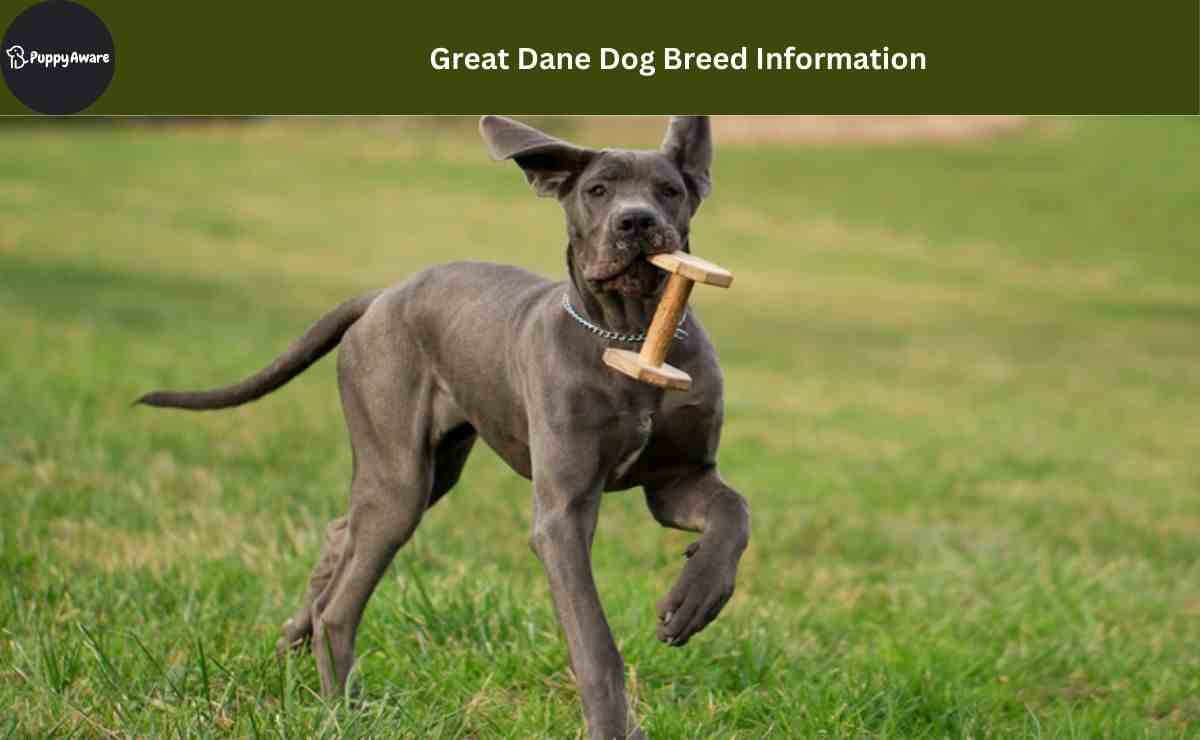Standing majestically at heights that rival some ponies, the Great Dane has earned its reputation as the “Apollo of Dogs.”
Despite their imposing stature, these gentle giants are known for their patient and friendly demeanor, making them one of the most beloved large dog breeds in the world.
Great Dane Dog Breed Information : The Gentle Giant’s Complete Guide

From their noble origins as boar hunters to their modern role as cherished family companions, Great Danes continue to capture hearts with their unique combination of grandeur and gentleness.
Lets explore more detailed info about the Great Dane Dog Breed.
Breed Overview
| Characteristic | Details |
|---|---|
| Height | Males: 30-34 inches; Females: 28-32 inches |
| Weight | Males: 140-175 pounds; Females: 110-140 pounds |
| Life Expectancy | 7-10 years |
| Group | Working Group |
| Temperament | Patient, Friendly, Dependable |
| Energy Level | Moderate |
| Trainability | High |
| Good with Children | Yes (with proper training) |
| Good with Other Dogs | Generally Yes |
| Shedding | Moderate |
| Grooming Needs | Low |
| Country of Origin | Germany |
Historical Background
The Great Dane’s ancestry can be traced back to ancient Egypt, with similar dogs appearing in artifacts dating to 3000 BCE.
However, the breed as we know it today was primarily developed in 16th-century Germany, where they were known as “Deutsche Doggen” or German Mastiffs. Initially bred to hunt large game like wild boar and bears, these dogs required both strength and agility.
What many don’t realize is that the name “Great Dane” is somewhat of a misnomer, as the breed has no direct connection to Denmark. The name likely emerged from the French naturalist Comte de Buffon, who saw a version of the breed while traveling in Denmark and called it “Grand Danois,” which eventually became Great Dane in English-speaking countries.
Early Breeding Standards
The breed underwent significant refinement in Germany during the 1800s:
- Breeders focused on tempering the dog’s aggressive hunting instincts
- Emphasis was placed on developing a more elegant appearance
- Selection for a stable, friendly temperament began
- First breed standard was established in 1880 in Berlin
Physical Characteristics & Appearance
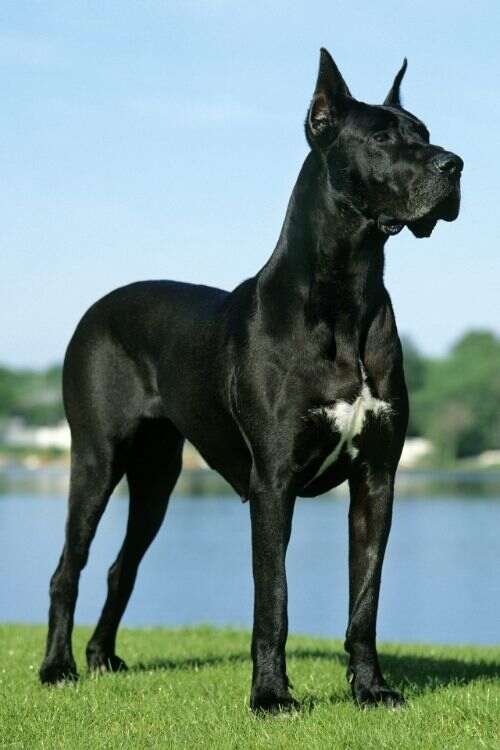
The Great Dane’s distinctive appearance makes it one of the most recognizable dog breeds worldwide. Their impressive physique combines strength with elegance, creating a well-balanced and regal appearance.
Size and Structure
Great Danes possess several unique structural characteristics:
- Head features a long, rectangular shape with pronounced stop
- Neck is high-set and elegant, showing natural arch
- Body displays a deep chest with well-sprung ribs
- Back line remains level and firm
- Tail tapers naturally to reach the hock joint
Official Color Varieties
The American Kennel Club recognizes several distinct color patterns:
| Color Variety | Description | Special Markings |
|---|---|---|
| Fawn | Golden to light brown | Black mask required |
| Brindle | Gold base with black stripes | Black mask preferred |
| Blue | Steel blue solid color | No specific markings required |
| Black | Glossy black | White markings permitted on chest |
| Harlequin | White base with black patches | No merle patches allowed |
| Mantle | Black base with white markings | Specific pattern required |
Lesser-Known Color Facts
Many people aren’t aware that:
- The merle pattern, while attractive, is not accepted in show rings
- White Great Danes are not albinos but a result of extensive white markings
- The gene responsible for the harlequin pattern can be lethal if inherited from both parents
- Blue Great Danes are born with a darker coat that lightens with age
Growth and Development
A unique aspect of Great Danes is their remarkable growth rate:
| Age | Average Male Weight | Average Female Weight |
|---|---|---|
| 8 weeks | 20-25 lbs | 15-20 lbs |
| 6 months | 90-100 lbs | 70-85 lbs |
| 1 year | 120-140 lbs | 100-120 lbs |
| Adult | 140-175 lbs | 110-140 lbs |
Important Note: This rapid growth period requires careful nutrition and exercise management to prevent developmental issues. Growth plates typically close between 12-18 months of age, making this a crucial period for proper development.
Temperament and Personality
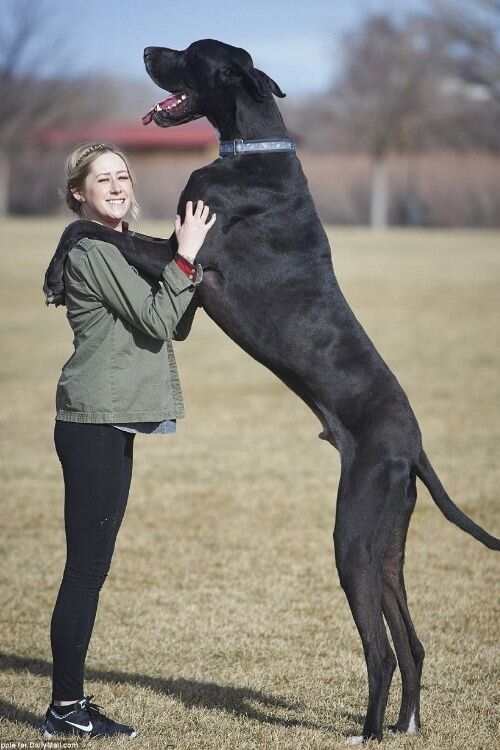
Despite their imposing size, Great Danes are often referred to as “gentle giants” for good reason. Their temperament sets them apart from many other large breeds, making them exceptional family companions.
Core Personality Traits
- Patient Disposition: Particularly evident with children and smaller pets
- Natural Dignity: Carries themselves with a calm, composed demeanor
- Social Nature: Thrives on human companionship and family interaction
- Moderate Energy: Despite size, not typically hyperactive or overly demanding
- Sensitive Spirit: Highly attuned to owner’s emotions and household mood
Common Misconceptions
Many potential owners have misconceptions about Great Danes:
| Misconception | Reality |
|---|---|
| “They need enormous space” | Adapts well to apartment living if exercised properly |
| “They’re aggressive due to size” | One of the gentlest large breeds |
| “They’re impossible to train” | Highly trainable with consistent, positive methods |
| “They need excessive exercise” | Moderate exercise needs compared to other large breeds |
| “They’re not good with children” | Excellent with kids when properly socialized |
Training and Socialization
Critical Training Periods
Early Puppyhood (8-16 weeks)
- Focus on basic commands and house training
- Gentle leash introduction
- Positive exposure to various environments
Adolescence (4-12 months)
- Advanced obedience training
- Structured socialization
- Impulse control exercises
Young Adult (1-2 years)
- Refinement of learned behaviors
- Advanced training if desired
- Ongoing socialization maintenance
Essential Training Considerations
Great Danes require specific training approaches due to their unique characteristics:
- Early Leash Training: Critical due to their eventual size and strength
- Proper Socialization: Must be carefully managed considering their imposing presence
- Jumping Prevention: Essential to address before full growth
- Furniture Rules: Must be established early, as size makes later changes difficult
- Gentle Training Methods: Harsh corrections can damage their sensitive nature
Socialization Checklist
For optimal development, expose your Great Dane puppy to:
- Different floor surfaces (tile, carpet, grass, concrete)
- Various weather conditions
- Different types of people (children, elderly, people with hats, etc.)
- Other animals (both large and small)
- Various sounds (traffic, household appliances, storms)
- Different environments (parks, streets, vet clinics)
Health and Longevity
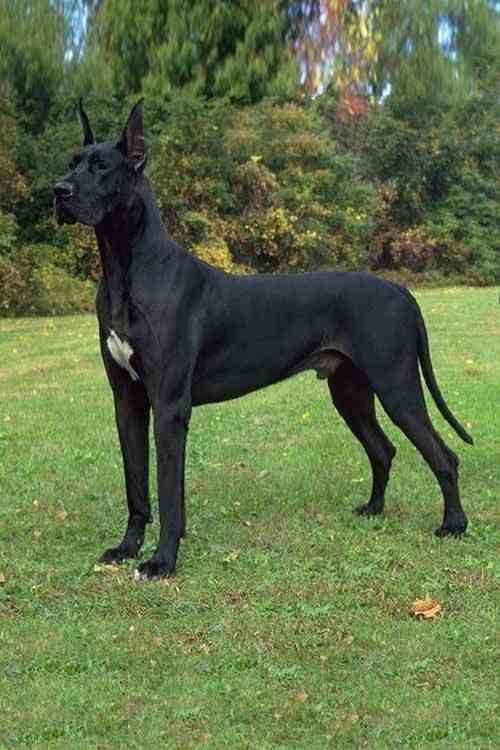
Great Danes, like many giant breeds, face specific health challenges that potential owners should be aware of. Understanding these issues is crucial for providing optimal care.
Common Health Concerns
| Condition | Description | Prevention/Management |
|---|---|---|
| Bloat (GDV) | Life-threatening stomach condition | Preventative gastropexy, managed feeding schedule |
| Hip Dysplasia | Joint malformation | Genetic testing, proper exercise, weight management |
| Heart Disease | Particularly DCM | Regular cardiac screenings, proper nutrition |
| Wobbler Syndrome | Spinal cord compression | Careful exercise, proper growth management |
| Eye Problems | Including entropion, ectropion | Regular veterinary checks |
Life Expectancy Factors
While the average lifespan is 7-10 years, several factors can influence longevity:
- Genetics and breeding quality
- Diet and nutrition management
- Exercise and weight control
- Preventative healthcare
- Living conditions and stress levels
Care and Maintenance
Nutrition Requirements
Great Danes have specific nutritional needs that differ from other breeds:
| Life Stage | Daily Caloric Need | Special Considerations |
|---|---|---|
| Puppy (2-6 months) | 3,000-4,000 calories | Controlled calcium levels |
| Adolescent (7-12 months) | 4,000-5,000 calories | Protein moderation |
| Adult | 2,500-3,000 calories | Joint support supplements |
| Senior | 2,000-2,500 calories | Weight management |
Critical Nutritional Guidelines:
- Avoid high-protein puppy foods
- Feed multiple smaller meals rather than one large meal
- Maintain strict feeding schedules
- Use elevated feeding stations
- Monitor weight and adjust portions accordingly
Exercise Requirements
Despite their size, Great Danes have moderate exercise needs:
Puppies (Under 1 year)
- 15-20 minute walks twice daily
- Avoid high-impact activities
- No forced exercise
- Supervised play sessions
Adults
- 30-45 minute walks twice daily
- Moderate play sessions
- Swimming (if interested)
- Mental stimulation activities
Grooming Needs
Great Danes have relatively simple grooming requirements:
Brushing
- Weekly brushing with firm bristle brush
- More frequent during shedding seasons
- Check for skin issues during grooming
Bathing
- Every 6-8 weeks unless needed sooner
- Use gentle, dog-specific shampoo
- Thorough drying important
Additional Care
- Regular nail trimming (every 2-3 weeks)
- Dental hygiene (brush 2-3 times weekly)
- Ear cleaning (check weekly, clean as needed)
Living with a Great Dane
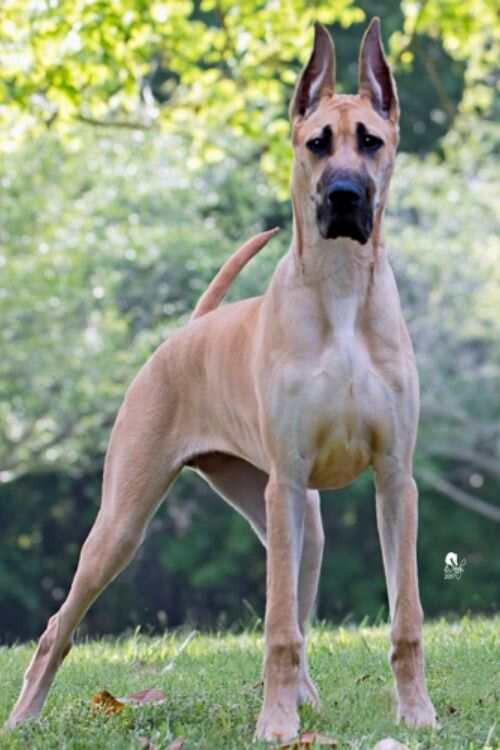
Space and Living Arrangements
Despite their size, Great Danes can adapt to various living situations:
Apartment Living
- Possible with proper exercise
- Need for comfortable resting spaces
- Consideration for neighbor comfort
- Access to outdoor areas important
Home Modifications
- Raised food and water stations
- Appropriately sized dog bed(s)
- Secured fencing (minimum 6 feet)
- Clear pathways through home
Cost Considerations
| Expense Category | Estimated Annual Cost | Notes |
|---|---|---|
| Food | $800-1,200 | Quality large breed food |
| Veterinary Care | $600-1,000 | Regular checkups and preventative care |
| Insurance | $600-900 | Recommended for breed-specific issues |
| Grooming | $200-400 | Including supplies and occasional professional service |
| Accessories | $300-500 | Beds, collars, toys (larger sizes needed) |
| Emergency Fund | $1,500-2,000 | Recommended minimum savings |
Family Integration
Children and Great Danes
- Supervision always required despite gentle nature
- Teaching children proper interaction techniques
- Establishing boundaries for both dog and children
- Creating safe spaces for both
Other Pets
- Generally good with other dogs
- Can adapt to cats with proper introduction
- May need management with very small pets
- Early socialization crucial
Special Considerations
Travel and Transportation
- Vehicle size requirements
- Planning for accommodation
- Exercise needs during travel
- Emergency planning
Climate Adaptation
- Sensitive to extreme temperatures
- Winter protection needed
- Summer cooling essential
- Indoor climate control important
Is a Great Dane Right for You?
Consider these final points:
- Commitment to size-specific care requirements
- Financial preparation for large breed expenses
- Lifestyle compatibility with breed needs
- Understanding of shorter lifespan
- Willingness to provide consistent training and socialization
With proper care, training, and understanding, a Great Dane can be an incredible addition to the right family, bringing joy, loyalty, and a touch of majesty to their owner’s lives.
Conclusion
Great Danes represent a unique combination of majesty and gentleness that makes them extraordinary companions. While their size presents specific challenges, their temperament and adaptability make them suitable for many different types of homes and families.
The key to success with a Great Dane lies in understanding their specific needs and being prepared for the responsibility of caring for these gentle giants.
